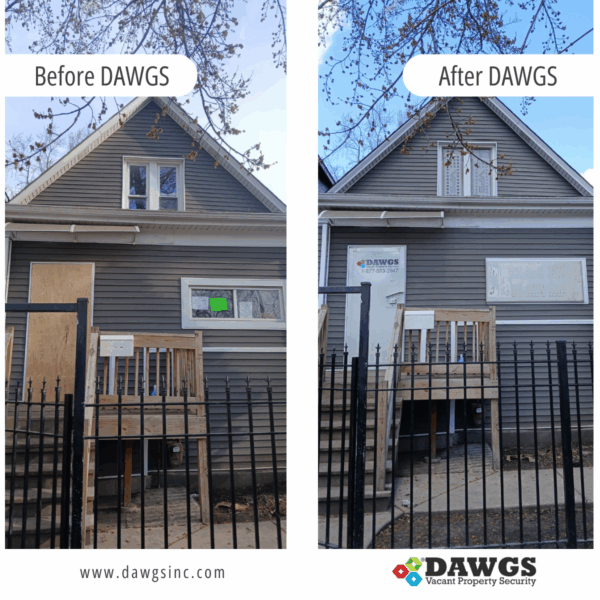Property managers across the United States face a critical challenge that directly affects their bottom line, client satisfaction, and neighborhood relations: finding effective vacant property security solutions. With over 16 million vacant housing units nationwide, the methods used to protect these properties have never been more important. As property vacancy rates fluctuate with market conditions, the need for reliable, long-term security solutions has become urgent for property management professionals.
The Property Manager’s Risk Equation
Managing vacant properties presents unique challenges that go far beyond collecting rent. Property managers must protect valuable assets against break-ins, fires, and legal risks—all of which escalate significantly when a property sits empty. According to Burns & Wilcox¹, vacant homes are prime targets for theft, squatting, and vandalism. They’re also high-liability environments due to tampering with electrical systems, fire hazards, and lack of upkeep.
The risks don’t end with the property itself. In many cities, visible signs of vacancy—such as plywood board-ups—can trigger municipal code enforcement, leading to costly fines and compliance issues. Without consistent, proactive security strategies, property managers face a constant uphill battle to protect investments and maintain client trust. Many property managers discover too late that their plywood installations violate local ordinances. Municipalities across the country have increasingly enacted regulations specifically prohibiting plywood board-ups, recognizing their contribution to neighborhood blight and crime.
Additionally, The National Fire Protection Association has identified plywood-secured vacant properties as significantly higher fire risks due to unauthorized entry and subsequent activities. For property managers, these regulatory violations can result in substantial fines that far exceed the cost of proper security measures.
Is your vacant property compliant? Learn more about local ordinances here.
When Vacant Properties Are Most Vulnerable
Certain timeframes present greater security challenges than others. Properties are most at risk during periods of transition, such as after disasters, during renovations, or between tenants. These high-risk windows create opportunities for unauthorized entry and damage if not secured quickly.
The Lincoln Institute of Land Policy² notes that vacant and abandoned homes attract crime and impose financial burdens on neighborhoods and local governments. Prolonged vacancies can destabilize entire communities. To comply with local ordinances and protect against neighborhood decline, property managers need durable, code-compliant solutions during these vulnerable windows.
When Should You Board Up a Vacant Property?
If you own or manage a vacant property, here are the most common situations when boarding up is necessary:
| When | Why |
| After a Disaster or Storm Damage | Broken windows and compromised doors leave a property vulnerable to additional damage and trespassing. Securing the building immediately can prevent further deterioration |
| During Renovations or Construction | Vacant properties undergoing repairs often contain valuable materials, tools, and equipment. Boarding up prevents theft and keeps work sites secure |
| Before a Sale or Foreclosure | Vacant properties awaiting new ownership should be boarded up to prevent damage and unauthorized entry, preserving their marketability |
| To Comply with Local Regulations | Many cities enforce strict vacant property ordinances that require property owners to secure abandoned buildings to prevent crime and maintain community safety. |
The Hidden Costs of Ineffective Vacant Property Security Solutions.
While plywood may seem like a convenient solution, it rarely holds up to long-term needs. Plywood can be breached in minutes using basic tools and often signals vacancy to would-be intruders. It deteriorates rapidly in weather, requiring constant replacement—especially in humid or rainy climates. These ongoing maintenance demands create operational headaches and erode profit margins.
Worse, many municipalities now prohibit plywood due to its role in neighborhood blight. Noncompliance with vacant property ordinances can result in fines that dwarf the cost of more reliable alternatives. Plywood also contributes to negative perceptions, increasing a property’s time on market and reducing resale value.
You may also be interested in Protecting Vacant Investment Properties: Understanding your alternatives to plywood board-up.
The Broader Financial Impact of Poor Security
The financial consequences of inadequate property security ripple far beyond one property. According to the Lake County Land Bank³, foreclosed and abandoned homes often sit vacant for extended periods and fall into disrepair. These conditions can depress nearby property values, attract crime, and create costly liabilities for both public agencies and private owners.
For property managers, poor security increases insurance costs, prolongs vacancy, and reduces resale values. Temporary fixes like plywood can undermine entire investment portfolios by contributing to visible neighborhood decline and diminishing long-term property performance.

Why DAWGS Is the Go-To Solution for Modern Property Managers
In this environment, more property managers are turning to DAWGS’ vacant property security solutions to replace traditional plywood. DAWGS’ patented solutions are tamper-resistant, weatherproof, and compliant with municipal codes in cities across the country—including Detroit, Chicago, Los Angeles, and New York.
With 24/7 protection and no need for frequent maintenance, DAWGS helps property managers reduce liability, meet ordinance requirements, and preserve neighborhood appeal. Their systems are easy to install and remove, making them ideal for properties in transition or under renovation.
Protect Value. Prevent Risk. Partner with DAWGS.
Stop patching problems with plywood. Start protecting your properties with DAWGS!
Ready to make the switch? Contact DAWGS today to discover how our steel security solutions can protect your properties, preserve your investments, and strengthen your reputation as a proactive, professional property manager.
_____________________________________________________________________________________________________
Sources
- Burns & Wilcox. “Unoccupied Homes Becoming ‘Hotspot’ for Squatters, Fires, Thefts and More.” Burns & Wilcox, January 29, 2025.
- Mallach A. “The Empty House Next Door: Understanding and Reducing Vacancy and Hypervacancy in the United States.” Lincoln Institute of Land Policy, 2018 [Free PDF]
- Klein A. “Understanding the True Cost of Abandoned Properties: How Maintenance Can Make a Difference.” Community Blight Solutions, 2017. [Free PDF]




